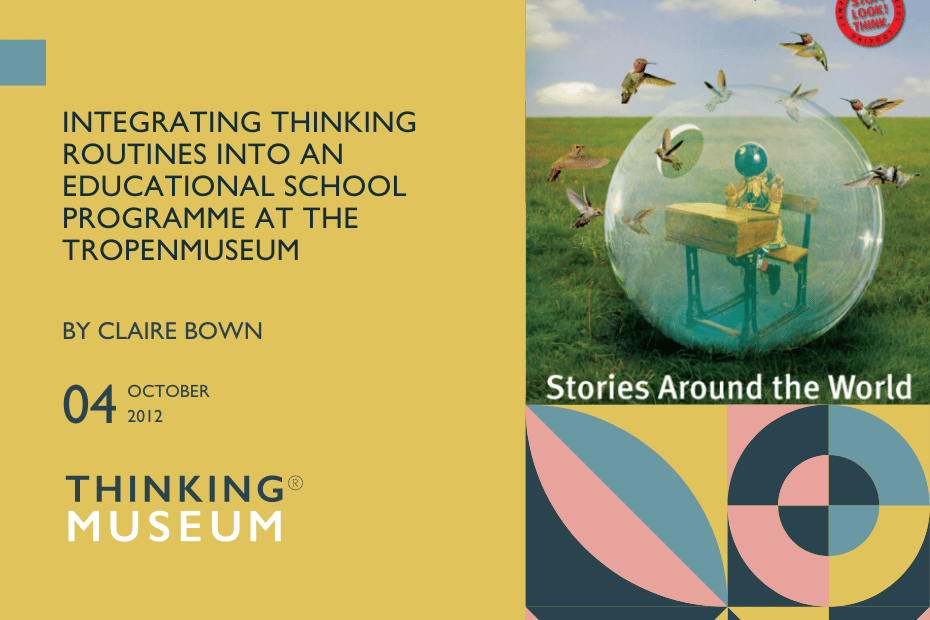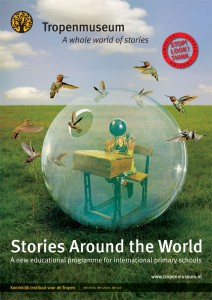Yesterday was a very proud moment for me. Over the past year (2011) I have been developing a new programme at the Tropenmuseum for international primary schools using thinking routines as a method of engaging and interacting with museum objects. We invited teachers from international schools all over the Netherlands to come to the museum yesterday to find out more and experience a taster of the programme for themselves.
There are two types of international schools in the Netherlands – private and so-called community schools. The latter receive a generous subsidy from the Dutch government which ensures school fees stay low. Community schools have an emphasis on students connecting and integrating into Dutch society and students receive regular Dutch language classes to help achieve this. The main language of instruction for approximately 13,000 students is English.
Therefore, when it comes to choosing a suitable museum visit, options are rather limited. At a focus group last year with several teachers, I found out that international schools are generally offered either a standard museum guided tour with an English-speaking guide or a translation of an existing worksheet. Teachers also remarked on frequently creating their own activities for the students to do at the museum. International schools tend to repeat the same visits year-in year-out because they know they ‘work’. English-language resources were also largely unavailable – teachers wanted information to prepare for visits and to follow up afterwards but found that access to educational resources involved supplemental hours of translation work.
With my own children at an international school in Amsterdam, I was also concerned that they were not experiencing the full potential of the many excellent museum learning initiatives out there. They were returning from museum visits to highly respected institutions remarking that the visit was ‘fine’, ‘ok’ or even ‘just someone talking at us’.
The Tropenmuseum wanted to develop a new programme for international schools – not least because of the reasons mentioned above, but also due to the fact that they both share an international outlook. That is, perhaps, a deep sense and awareness of other peoples, cultures, countries and customs. The Tropenmuseum’s collection spans many continents and focuses on contributing to the knowledge and understanding of different cultures. The Tropenmuseum is also part of the Royal Tropical Institute (KIT), a knowledge institute for international and intercultural collaboration. Internationals schools themselves offer a small representation of the world and their students can teach us about their own cultures.
The new programme needed to reflect this shared outlook and offer a common link between various curricula on offer in international schools. The International Primary Curriculum (IPC) and the International Baccalaureate Primary Years Programme (IB PYP) are both pedagogically progressive curricula focusing on a skills-based approach using transdisciplinary units of study, with the aim of developing adaptable and resilient globally-minded learners.
The resulting programme ‘Stories Around the World’ focuses on all of the above elements. The theme chosen for the programme, stories and storytelling, reflects the need for a broad, flexible topic that is applicable across the primary years and across different curricula. There is an accompanying Teacher’s Pack available for every teacher providing detailed information and resources in English. I have also developed a new teaching method Stop! Look! Think. for the programme over the past year which aims to encourage slow, detailed exploration of objects using thinking routines from Project Zero’s Visible Thinking project. Expect more information about the method in future posts soon…
The initial response to the new programme yesterday was wholeheartedly enthusiastic and positive. So, I am feeling proud today – pleased to have developed the first museum programme specifically for Dutch international schools using Visible Thinking routines.


Pingback: A Brief Guide to Thinking Routines